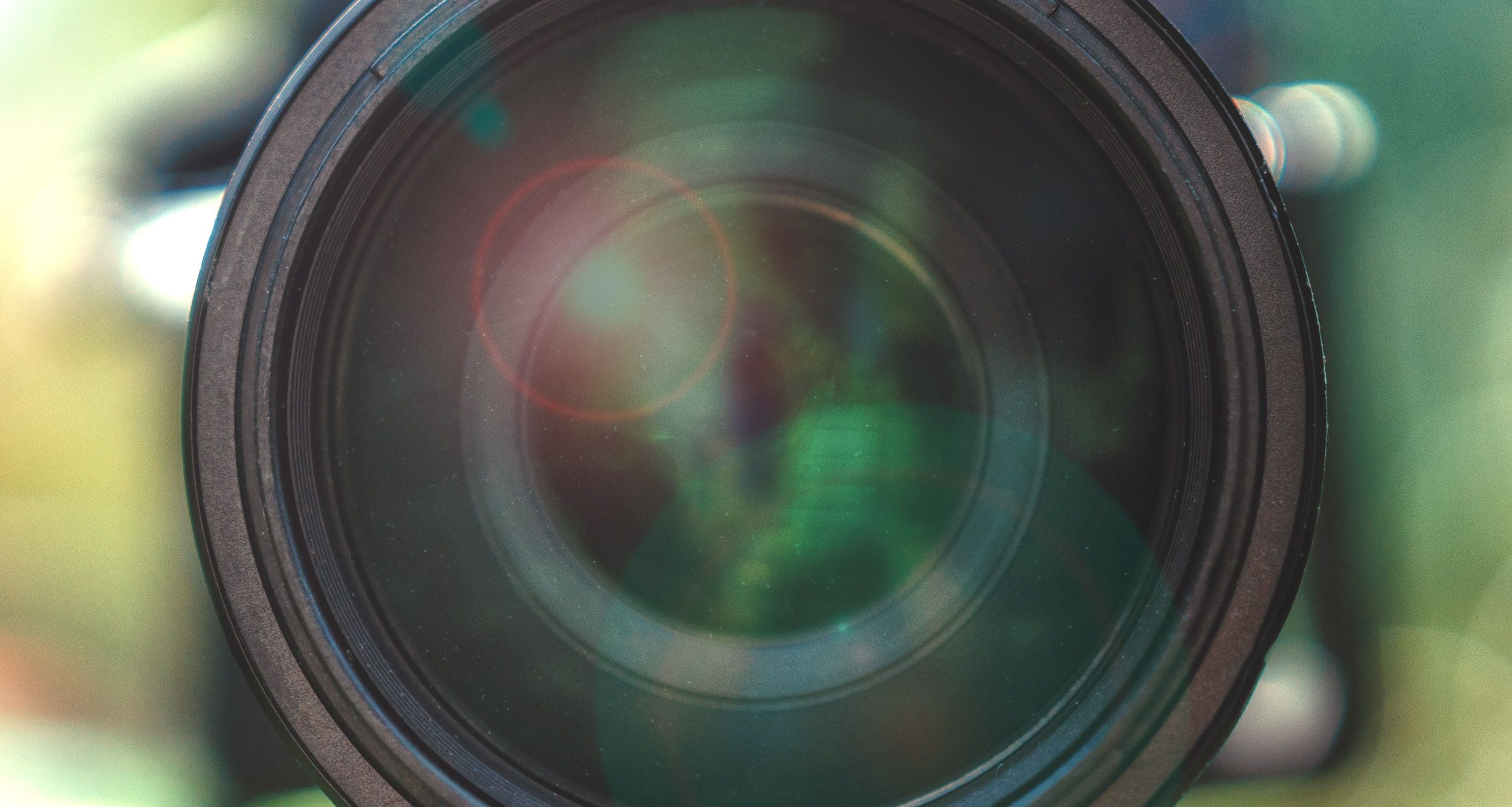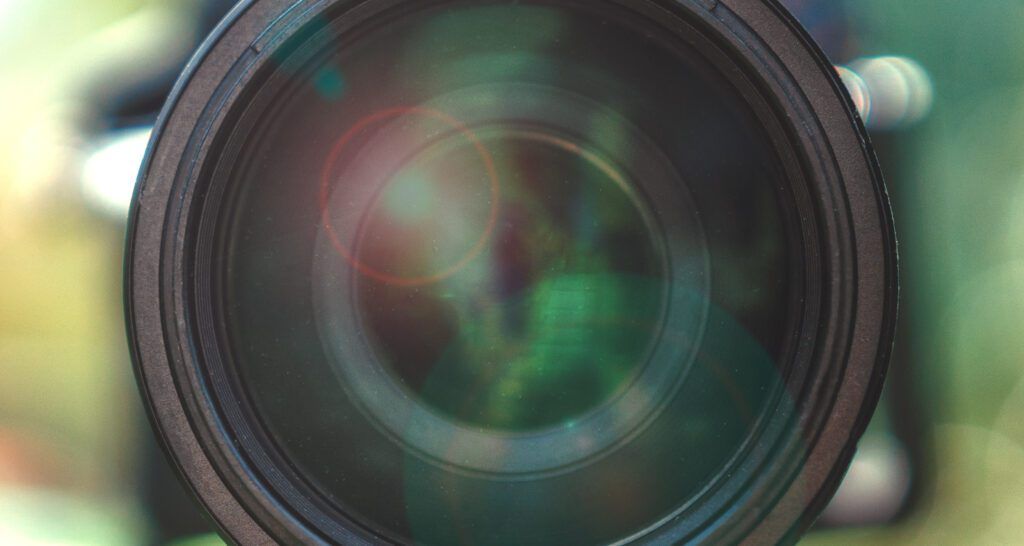A zoom lens is a versatile tool in your camera bag. You can get close when the world throws up barriers. You can see beyond what the human eye can see. You can visit many visual worlds with one lens. But “zoom” is a broad description of a lens. The marketplace is filled with numerous zoom lenses. Each is different, carrying confusing numbers and descriptions.
In this guide, we’ll explore the features of zoom lenses. We’ll talk about the pros and cons of using a zoom lens and how features are described by lens designers. We’ll give you the tools you need to decide if a zoom lens is right for you. Then, we’ll discuss how to use it once you have a zoom in your kit.
What we’ll cover:
- Definition of a zoom lens
- Reasons to use a zoom lens
- Features of a zoom lens
- Composing with a zoom lens
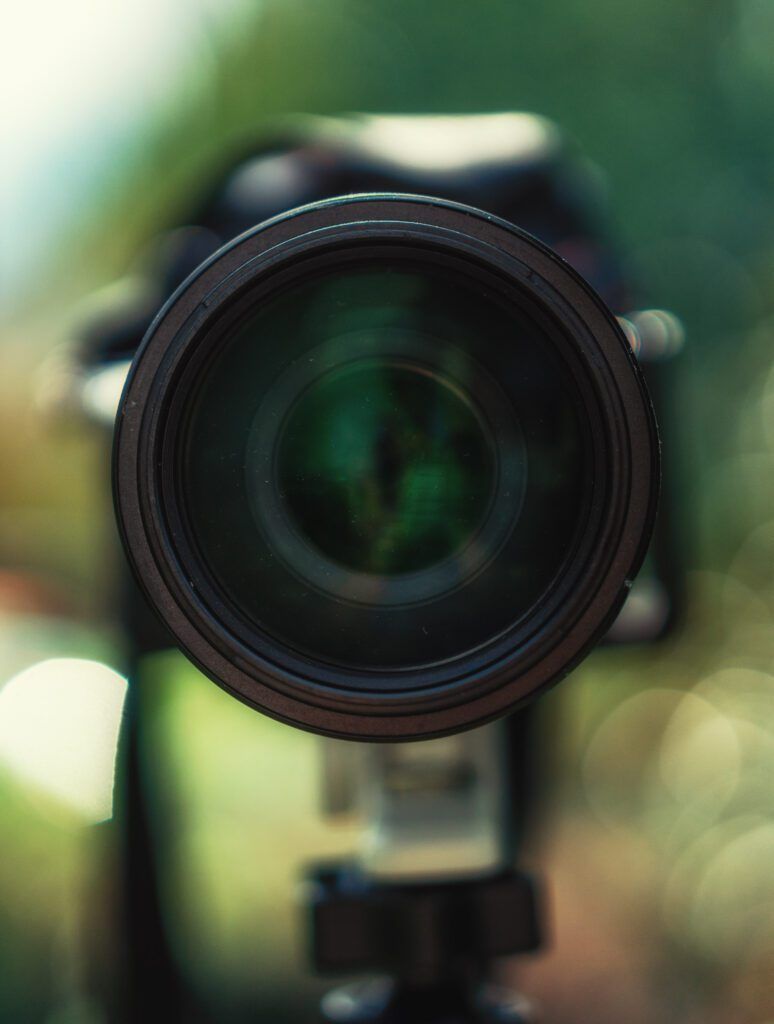
Photograph by Jenn Mishra
Recommended Reading: If you’d like to master camera settings to create gorgeous, creamy, blurry backgrounds, grab a copy of Photzy’s premium guide: Beautiful Background Blur.
What Is a Zoom Lens?
A zoom lens is designed to have more than one focal length. You change the focal lengths by twisting the barrel of the lens. You can go from a wide focal length to a longer one. The range of the zoom depends on the lens. On most zoom lenses, the barrel of the lens extends as you twist. On some lenses, the barrel stays the same length even when the focal length changes.
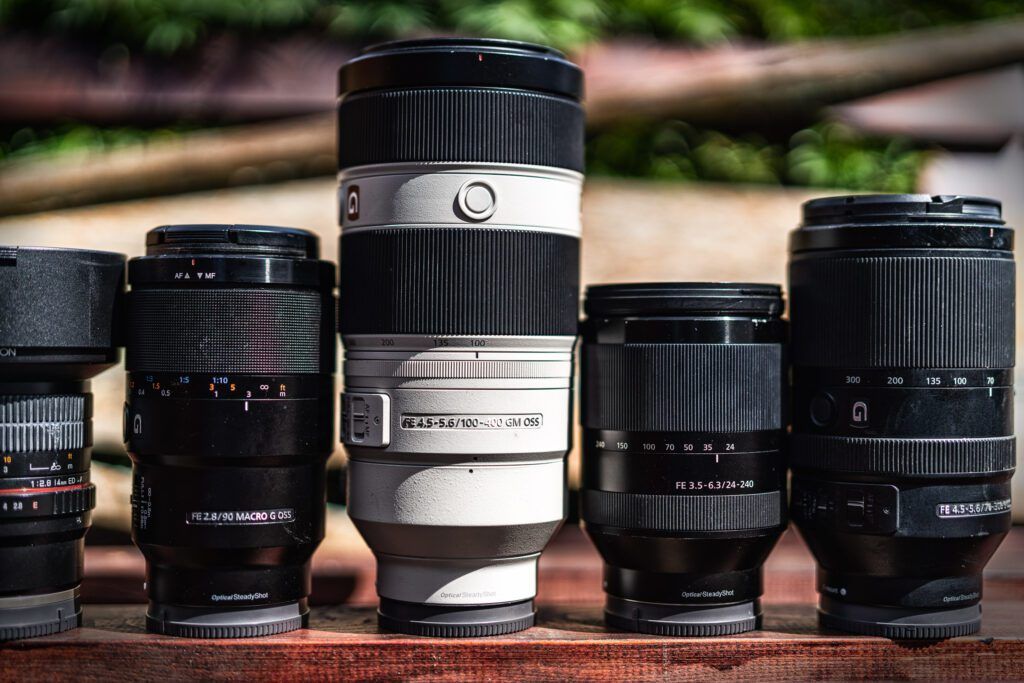
A variety of zoom and prime lenses. Photograph by Jenn Mishra
Zoom lenses contrast with prime lenses, which are fixed at one focal length. In the past, it was always assumed that prime lenses would give you sharper images. But with today’s advances in lenses, this is not always the case. Quality zoom lenses can be as sharp as prime lenses.
Since flexible focal lengths are key to zoom lenses, let’s look at how focal lengths are measured.
Focal Length
Focal lengths are measured in millimeters (mm). Changing the focal length changes how much of the scene in front of you are captured by the lens. The lower focal length numbers have a wider field of view and show more of the scene. Higher focal lengths magnify the scene and have a narrower field of vision. The focal length of the human eye is around 50mm (measured at 43mm). This equates to about a 55° field of view. The focal length of the human eye is fixed. We can switch our attention to different parts of the scene. This makes them seem more prominent in our minds, but we cannot change our field of view. With zoom lenses, we can change how much of the world we see through our viewfinder.


Standing in a sunflower field, you can explore many different compositions with a zoom lens. The top image was taken at 69mm, the bottom at 172mm. Photographs by Jenn Mishra
Some zoom lenses cover a small range of focal lengths. Others have a wide range. For instance, a zoom lens may be 10-18mm. The widest focal length is 10mm. The maximum focal length is 18mm. Other lenses cover a broad range of focal lengths, like the Sony 100-400mm zoom lens. The widest angle the lens captures is 100mm.
Zoom lenses can be wide-angle, telephoto, or cover the range in between. You can even have zoom lenses that cover all three. A 10-18mm zoom lens is an ultra-wide-angle lens. A 100-400mm is a telephoto zoom lens. A 24-240mm zoom lens covers a range that includes both wide-angle and telephoto.

Lenses fall into categories based on focal length. Zoom lenses are made for each category and even cross-over categories. Photograph by Jenn Mishra
Standard, mid-range lenses cover what we would naturally see with the human eye. Wide-angle lenses let you capture a field of view that is wider than what we can naturally see. Telephoto lenses let us see deeper into a scene, like a telescope. Longer focal lengths narrow the scene and allow us to get visually closer to our subject.
The focal length of the human eye is fixed. We can switch our attention to different parts of the scene.
There are no standard zoom ranges. They vary across lens manufacturers and even within one company’s lens line-up. For instance, Sony makes a 24-70mm, a 24-105mm, and a 24-240mm lens. They also make a 28-60mm and a 28-70mm lens. Currently, the widest camera lenses are 8mm. These are called “fisheye” lenses because of the distorted view. The longest telephoto camera lenses can be upwards of 1500mm. But the longest practical length that you will see commercially available is 800mm.
Landscape photographers generally favor wide-angle lenses. Wildlife and sports photographers like telephoto lenses. Portrait photographers often work in the mid-range, but they sometimes use short telephoto lenses. There are no hard-and-fast rules. Use the range that you like the best, whatever type of photography you do.
Zoom Ratio
Lens makers describe their lenses with a zoom ratio. This lets you compare zoom lenses without considering specific focal lengths. Compute the ratio by dividing the maximum focal length by the widest focal length.
A zoom lens with a range of 12-24mm is a 2x zoom lens. This is the same zoom ratio as a 200-400mm lens, even though the lenses cover a different range of focal lengths. A 100-400mm lens has a zoom ratio of 4x, and a 24-240mm zoom lens has a large, 10x zoom ratio.
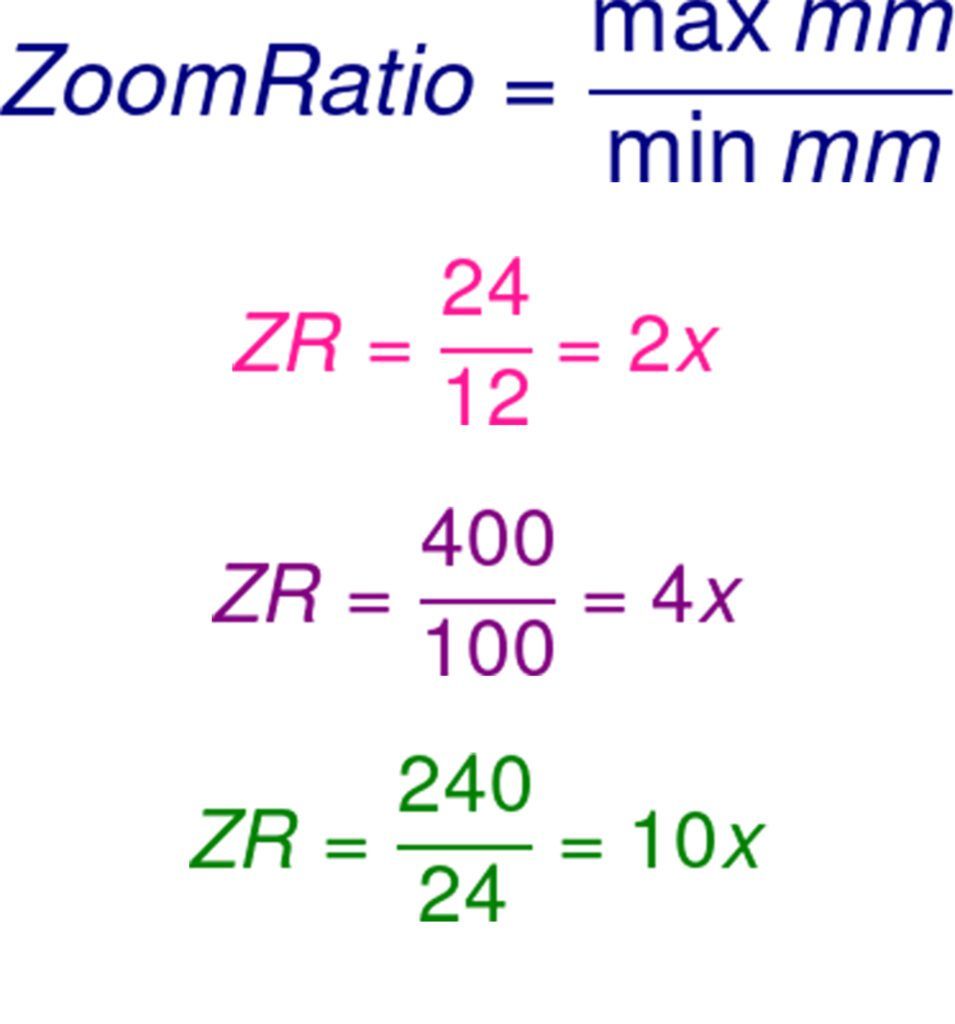
Compute zoom ratios by dividing the maximum focal length by the minimum focal length. Illustration by Jenn Mishra
Crop Senor Conversion
All lens manufacturers use focal lengths that correspond to a full-frame, 35mm camera. If your camera has a crop sensor, you need to do a simple conversion. This will give you the equivalent focal lengths of the zoom lens.
First, look up the crop factor of your sensor. This will be in the description of your camera. For instance, Fuji cameras and the Sony APS-C series (e.g., A6600) have a crop factor of 1.5x. Multiply the focal length of the lens by the crop factor of your camera. For instance, a 16-35mm zoom lens converts to a 24-52mm field of view on a crop sensor camera.
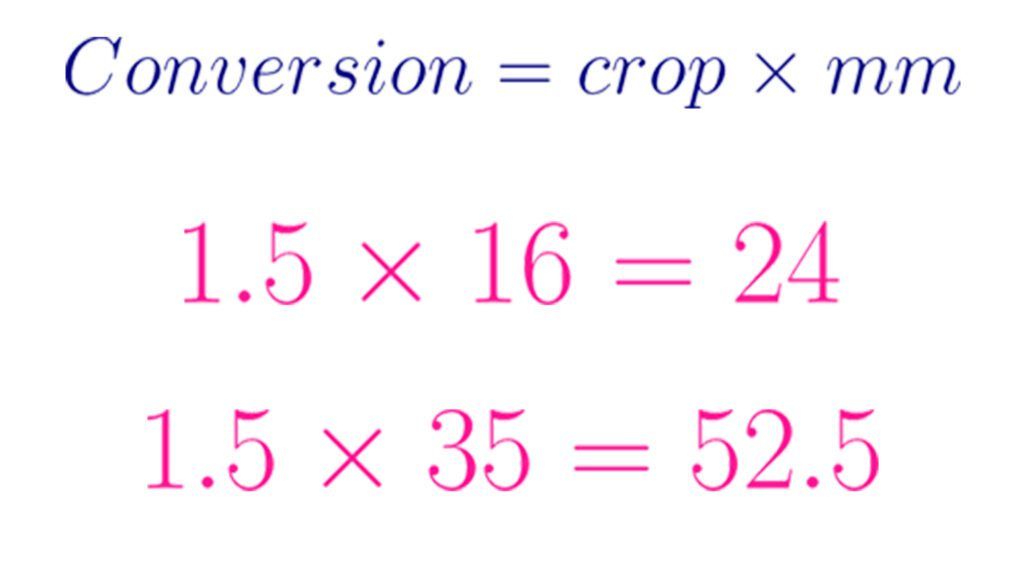
Convert focal lengths for crop sensor cameras by multiplying the maximum and minimum focal lengths by the crop factor. Illustration by Jenn Mishra
In general, crop sensors narrow the field of view, getting you a little closer to your scene. This can be a way of extending the zoom power of a lens on a full-frame camera. On my full-frame Sony, I have programmed a button to switch from full-frame to crop sensor (APS-C). This effectively gives me an extra 1.5x extension. The maximum 400mm on my telephoto zoom lens becomes 600mm! But there is a catch. By making my camera a crop sensor, I lose some of the megapixels of my sensor. My focal length is 600mm, but I only have 18MP out of my 42MP. This is a trade-off. But the smaller image is still plenty large.
Recommended Reading: If you’d like to master camera settings to create gorgeous, creamy, blurry backgrounds, grab a copy of Photzy’s premium guide: Beautiful Background Blur.
Pros and Cons of a Zoom Lens
The primary reason to use a zoom lens is flexibility. Even in cases where prime lenses are sharper than zooms, there is a practical consideration. Changing the focal length of a prime lens means physically changing the lens. This takes time and opens your camera up to dust. Photographers who use prime lenses learn to work within the limitations of the focal length. But for many photographers, life happens both near and far. We sometimes want to capture a scene close to us. Sometimes the action is further away. Zooms give us the flexibility to capture both without changing lenses.
Use a zoom lens when you cannot get physically closer to your subject. Some landscapes limit where you can walk. For instance, you cannot physically walk out onto a lake to get closer to the mountains on the other side. You also cannot step out onto a sports playing field when a game is in progress. When you can move closer, your relationship with the subject also changes. What you see is different. Some photographers argue that getting physically closer is better, but it is simply different.


These two images were taken from the same position along the shores of Lake Superior. The top image was taken at 35mm and the bottom at 160mm. Photographs by Jenn Mishra
A mid-range zoom is good for exploring a place for the first time. If you do not know what focal length is best, start in the middle. A 24-70mm lens is a popular mid-range zoom. These lenses give you a lot of flexibility for travel and street photography. Use a wide-angle 16-35mm when you know that you will be photographing scenes with scale. You may be trying to capture a grand landscape or architecture. Use a telephoto zoom, like 100-400mm, when taking photos of intimate landscapes, wildlife, or sports.
Weight becomes a consideration with longer telephoto zoom lenses. They can be heavy. For instance, the Sony 200-600mm telephoto zoom lens is more than 4-½ pounds (2115 grams). Technically, you can handhold the lens, but not for long. You will need to use a tripod or monopod to stabilize the lens and take the weight off your body.
Features of a Zoom Lens
Zoom lenses have many features, some in the form of extra buttons or dials on the lens. There is a series of numbers that describe the zoom lens. Let’s look at what the numbers mean.
Fixed vs. Variable Aperture Zoom Lenses
One of the numbers describing a zoom lens is the aperture or f-stop. This may be one number or a range of f-stops. These numbers tell you whether the zoom lens has a fixed or variable aperture. For instance, Sony makes these two lenses:
- Sony 24-70mm f/2.8
- Sony 24-240mm f/3.5-f/6.3
The lens with only one f-stop is a fixed aperture zoom lens. The one with a range of apertures is a variable aperture zoom lens.
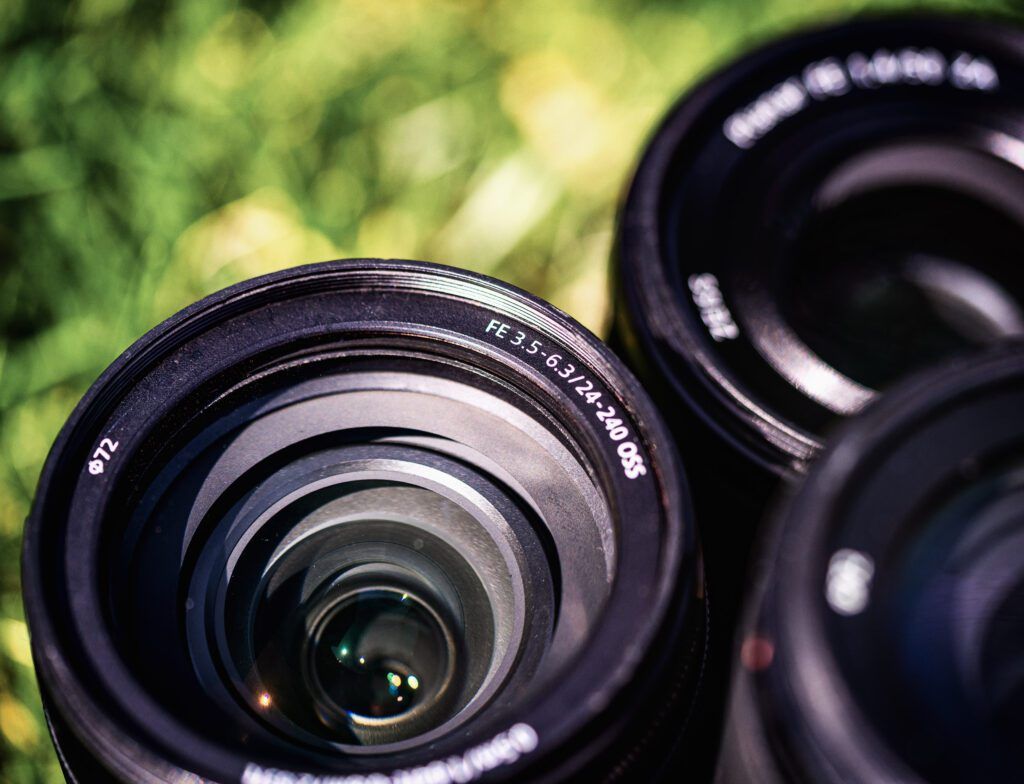
Zoom lenses come in all sizes and focal lengths. The set of numbers printed on the lens describes the type of zoom lens and the focal lengths covered. Photograph by Jenn Mishra
With a fixed aperture zoom lens, the widest aperture does not change as you zoom. You can use f/2.8 on the Sony 24-70mm f/2.8 at 24mm and 70mm. With a variable aperture zoom lens, the widest aperture changes as you zoom. For the Sony 24-240mm f/3.5-f/6.3, you can use the widest aperture only at the widest focal lengths. But if you zoom in to 240mm, the widest aperture available to you is f/6.3. The lens lets in less light when fully extended.
With a variable aperture zoom lens, the widest aperture changes as you zoom.
If you set a wide aperture and then zoom in, your camera will change your aperture, even if you are in Aperture Priority or Manual mode. If you select f/5.6 at 24mm on the Sony 24-240mm f/3.5-f/6.3 and then zoom in to 200mm, your camera will change the aperture to f/6.3. This can be confusing if you do not understand that your zoom lens has a variable aperture. It looks like your camera is overriding your settings. Your camera should adjust back to your original settings when you zoom out again.

The settings for this image of a landing Great Blue Heron were f/8.0 at 1/500th of a second at 560mm, ISO 6400. I used my 100-400mm zoom lens fully extended with an additional 1.4x extender to achieve a focal length of 560mm. This limited me to f/8.0. The sun was setting, and I raised my ISO to keep my shutter speed fast. A little de-noise in post-processing removed most of the grain created by the higher ISO. Photograph by Jenn Mishra
Fixed and variable zoom lenses have different internal construction. As you zoom in, the elements inside the lens move. With variable aperture lenses, the elements shift and block some of the light coming into the lens. Lens designers use more sophisticated lens elements to stop this from happening. These are generally heavier and more expensive to produce.
For most photographers, this does not make a difference. If you often shoot in sunny conditions with lots of light or do not use the widest apertures, then a variable aperture zoom lens is fine. But if you photograph wildlife at dusk or sports in a dim arena, then you should consider the more expensive fixed aperture zoom lenses. You can use wider apertures at all focal lengths.
If you have a variable aperture zoom lens, know the limitations of your lens. You can increase your ISO to compensate for the loss of light at greater focal distances. In post-processing, a denoise program can take care of the residual noise.
Internal Stabilization
Zoom lenses may also have internal stabilization. The lens is constructed with floating internal elements attached to a gyro and microprocessor. As the lens moves, the gyros send the information to the microprocessor. The floating elements adjust in the opposite direction to compensate. This helps stabilize your image and remove the camera shake. This is especially important with a telephoto lens at slow shutter speeds.
The Reciprocal Rule (or Handheld Rule) refers to how slowly you can handhold your camera without seeing the camera shake. That means you should shoot with a shutter speed faster than 1/100th when using a 100-400mm lens. When this lens is fully extended, your minimum shutter speed is 1/400th of a second. Slower shutter speeds may show a slight blur in your image.

My zoom lens let me visually join this Nashville musician on stage. Image stabilization lets me break the Reciprocal Rule and capture this image at 144mm, f/6.3 at 1/30th of a second, ISO 5000. Photograph by Jenn Mishra
Image stabilization extends your options. You may be able to shoot one, two, even up to five stops slower. At 400mm, with one extra stop of image stabilization, you can shoot at 1/200th of a second without seeing the camera shake. With two stops of image stabilization, you can slow to 1/100th of a second.
One note about image stabilization: turn it off when mounting your camera on a tripod. When the camera is not moving, the IS system can work against itself. It adjusts for the movements of the IS system itself. This ironically creates the very motion blur that the IS system is trying to avoid. Image stabilization systems are improving, and some can detect when the camera is on a tripod. But if this is not specifically noted in the description of the IS system, it is best to turn it off.
Tripod Collar
Zoom lenses may be long and heavy. You can handhold the lens, especially with image stabilization, but it will not be pleasant over the long term. Your arms will tire! Zoom lenses may have a tripod collar. This allows you to mount the lens, not the camera, to a tripod. Camera manufacturers know that the center of balance of your camera system changes as the lens becomes longer and heavier. Mounting your zoom lens at the collar rather than at the camera moves the center of balance to a more stable position.
Zoom lenses may be long and heavy. You can handhold the lens, especially with image stabilization, but it will not be pleasant over the long term.
If your zoom lens has a tripod collar, do not mount your camera on the tripod. Mount your lens on the tripod. If you do not use the tripod collar, the extra weight of your lens pulls down on the front of your camera and could cause damage.
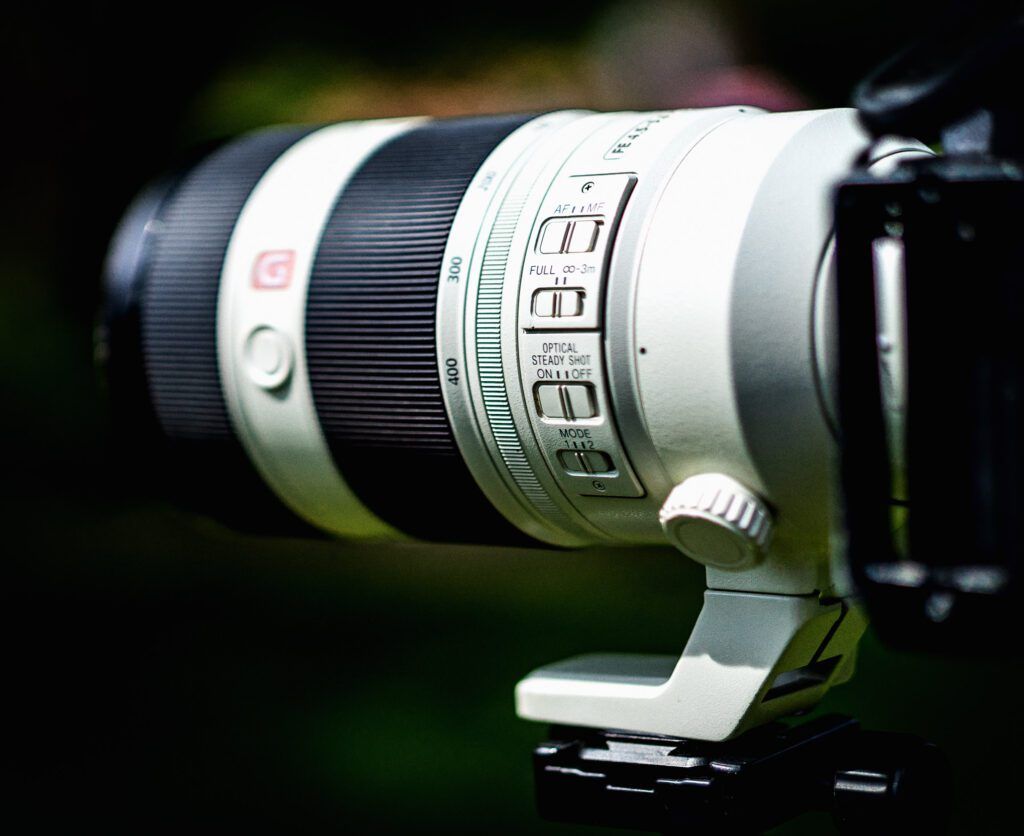
This 100-400 zoom lens includes a tripod collar and buttons that control other features of the lens like autofocus and image stabilization. Photograph by Jenn Mishra
Other Features
Zoom lenses may come with other features in the form of buttons on the lens barrel. You may be able to toggle image stabilization on and off and between auto and manual focus. You also may be able to lock the barrel. Telephoto lenses are heavy, and they sometimes extend under their weight as you carry the lens. Locking the barrel prevents this. You may also be able to change the focusing distance. This can effectively make your zoom lens a macro lens.
Composing With a Zoom Lens
With a zoom lens, you can be precise in your composition. Think carefully about the frame and zoom to focus on your subject and remove distractions. Take your time. Get the image right in the camera. This effectively crops your image in-camera, and your image will be at its maximum resolution. You get to keep all the pixels your camera gives you in the final image rather than cutting some away when cropping.
You can stand in one place and find a variety of compositions just by changing your focal length. You can capture a wide scene. Then, zoom in for a closer look.



From the same point, I captured a quintessential Smoky Mountain layered photo at 100mm (top). Then, I explored the valley below with my zoom lens, getting closer at 212mm (middle) and closer at 400mm (bottom) where I found a more intimate scene. Photographs by Jenn Mishra
Zoom lenses may cover both wide-angle and telephoto focal lengths, but the results will look different. Telephoto focal lengths compress the scene. Things in the background appear closer to your subject. With wide focal lengths, the reverse happens. You may even get visual distortions. These are not necessarily a problem. You may even want to compose with these visual effects in mind. Just know that a 24mm image does not look the same as a 240mm image, even if the subject is the same relative size in the frame.
Also, your depth of field will get shallower at the telephoto focal lengths. A wide aperture like f/2.8 will give a much shallower depth of field at 400mm than 100mm.
There may be other distortions, depending on your lens. Because of the lens’ construction, you may see vignetting at the longer focal lengths. Parts of the lens and the lens barrel block some of the light from entering your camera. Many of these distortions are known. A profile is developed for each lens. Advanced photo editing programs like Adobe Lightroom use the specific lens profile to counter the distortions.
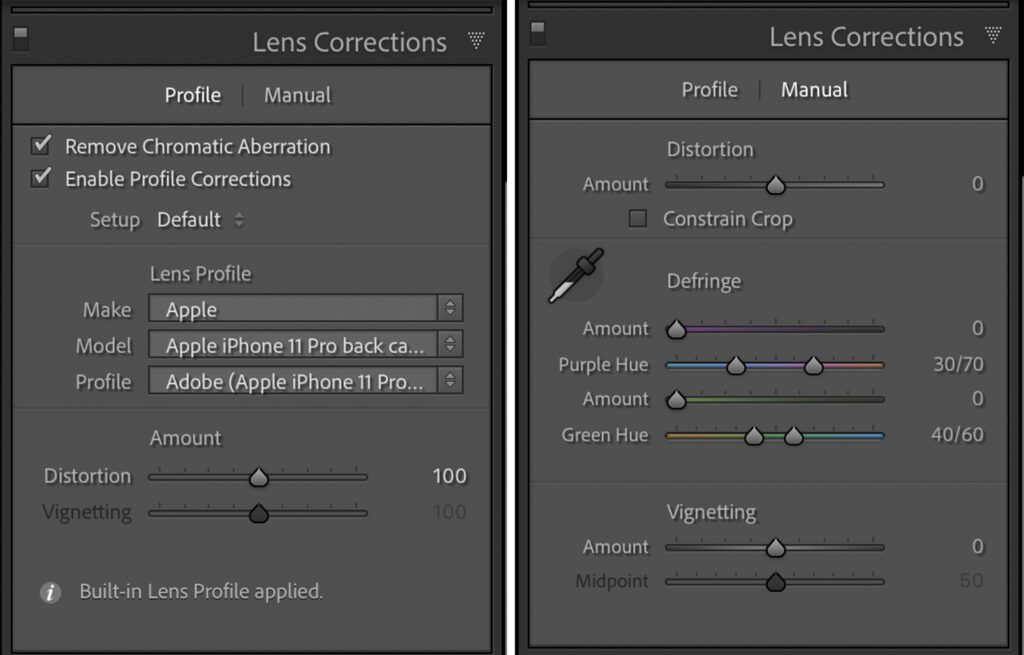
Screenshot of Lightroom Lens Correction panel in the Develop module. Photograph by Jenn Mishra
Conclusion
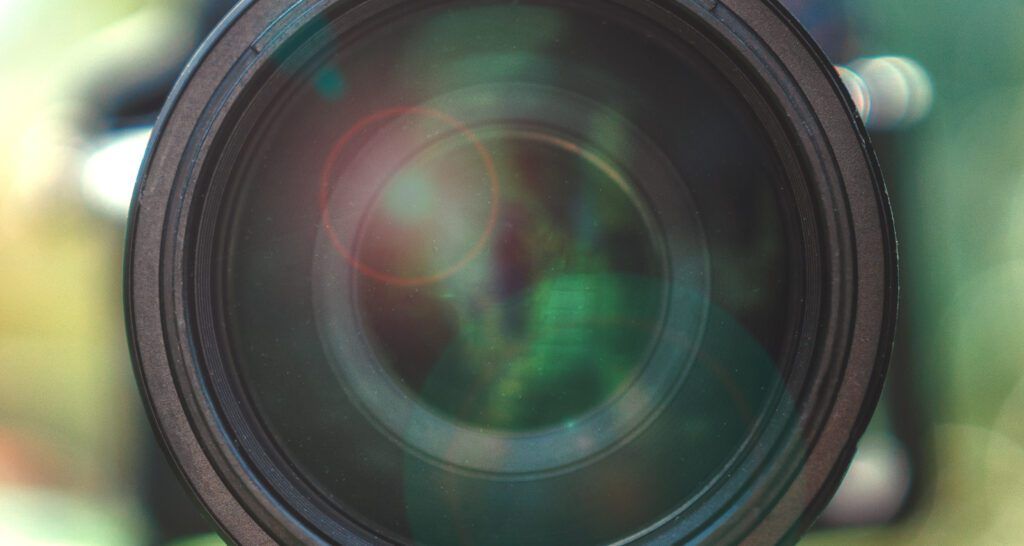
Photograph by Jenn Mishra
Zoom lenses are the popular choice in today’s digital photography world. Which zoom lens is right for you depends on what you like to photograph and how you see the world.
If you have been photographing for a while, look at your favorite focal lengths. This may give you a clue as to what zoom lens is best for you. Do you often use wide angles, or do you always want to get closer to your subject?
Photographers often have a set of zoom lenses that includes a 16-35mm, a 24-70mm, and a 100-300mm (or 400). These three lenses cover most focal lengths and are useful across many different situations. But there are a lot of other choices.
Zoom lenses are the popular choice in today’s digital photography world. Which zoom lens is right for you depends on what you like to photograph and how you see the world.
A zoom lens gives you flexibility when composing your image. They allow you to change how you see the world with a simple turn of the barrel. There are a variety of zoom lenses across the entire range of focal lengths. You can find wide-angle and telephoto zoom lenses and lenses that cover the focal lengths in between.
Lens designers make zoom lenses in all sorts of focal length ranges and with different features. Some are more expensive than others. You do not need to have them all. It is a matter of finding the zoom lens that works for you.
Recommended Reading: If you’d like to master camera settings to create gorgeous, creamy, blurry backgrounds, grab a copy of Photzy’s premium guide: Beautiful Background Blur.
Self-Check Quiz:
- How does a zoom lens differ from a prime lens?
- How do you compute a zoom ratio?
- True or false: Zoom lenses are always wide-angle.
- What are the converted focal lengths for a 24-70mm lens for a camera with a crop sensor of 1.4x?
- Describe two reasons for using a zoom lens.
- How does a fixed aperture zoom lens differ from a variable aperture one?
- What is a tripod collar?
- How might a photo taken at 16mm differ from one taken at 100mm even if the subject is the same size within the frame?
- What is the focal length of the human eye?
- Is the human eye more like a prime lens or a zoom lens?
Assignment:
Use a zoom lens that you own or one that you borrow. Stand in one place and explore the compositional capabilities of the lens. Start at the widest focal length. What type of compositions can you make? What can you include? Is there visual distortion, especially around the edges of the frame? Move to the maximum focal length of the lens. How do your compositions change? Frame multiple compositions from this one position. Explore the focal lengths in the middle of your lens. Note which might be better for certain types of compositions.


